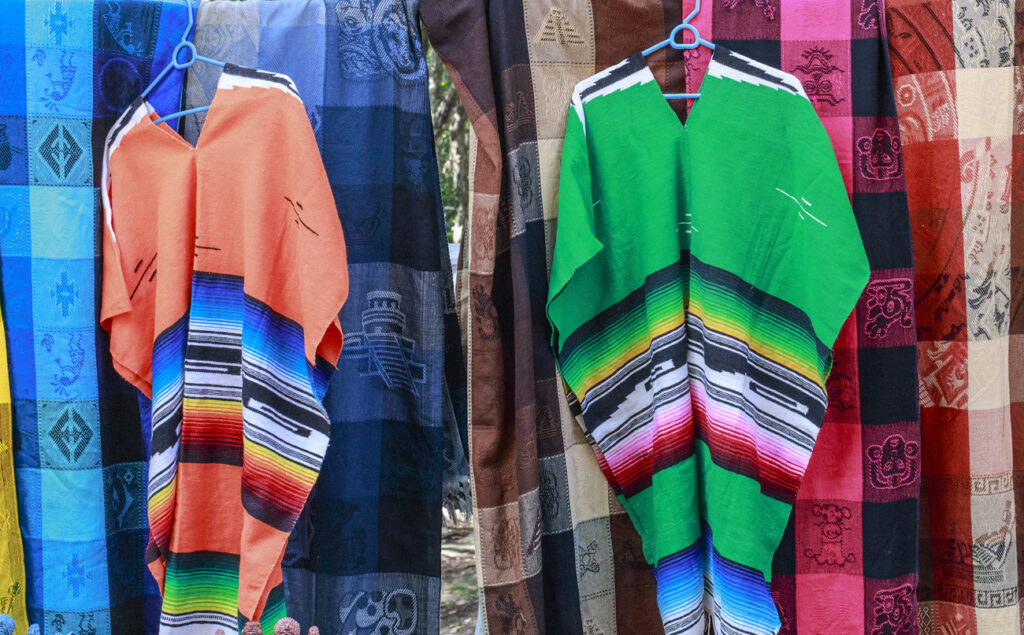When I was in college, I had a genuine Mexican poncho, and I loved wearing it. I always felt cool and dangerous when I had it on. It was the kind of thing that Clint Eastwood wears in A Fistful of Dollars. It was fringed and had a dramatic Aztec-inspired pattern woven into it, and it was light enough to wear during the day but heavy enough to keep me warm on cool nights.
I know what you’re thinking. You’re thinking, Privileged white guy wears culturally appropriated garment? Light the torches! Let’s get him!
Let me stop you right there. The poncho was a gift from my maternal grandmother, who was, in fact, a Mexican lady and had every right to present her grandson with a snazzy garment traditional to her heritage. And by the complicated ethnic arithmetic we all must do these days, the poncho is traditional to my heritage, too, or at least 25% of it. Which means that I was allowed to wear the poncho one-quarter of the time, which is about seven days a month, and as long as I kept to that ethno-sartorial limit, I was in the clear.
In fact, I wore it a lot less. I looked really cool in it — you’re just going to have to take my word for that — but it turns out that when you wear a poncho around, people make comments. They roll their eyes. I even encountered someone who told me that he “didn’t need no stinkin’ badges,” which was especially insulting because I am a film buff and Treasure of the Sierra Madre is one of my favorite movies. Also, Alfonso Bedoya isn’t even wearing a poncho when he spits out those words to Humphrey Bogart. He is wearing a giant sombrero, though, but I had enough sense back then not to try wearing one of those. Especially with the poncho, I’d come off less Clint Eastwood and more Frito Bandito.

But that’s the thing about style. If you have an off-beat and distinctive look, you have to be prepared for a little pushback. I’m ashamed to say that I didn’t break out the poncho much after the first few disastrous outings — I’ve worn it considerably less than my Ancestry.com account authorizes — and now I mostly wear it on the roof, on chilly afternoons, when I go up there to smoke a cigar. (Tobacco, by the way, is a sacrament to my people — well, to 25% of them — so please keep your privileged health judgments to yourself and let me celebrate my culture.)
The other 75% of my ethnic makeup, if you’re interested, is a classic mix of Anglo-Saxon, Celt, and Scot, which means that I’m also allowed to wear the vintage tweed Norfolk jacket I have hanging in my closet. A Norfolk jacket is a classic piece of menswear — it’s a heavy wool jacket, longer than a normal sport coat by an inch or two, used mostly for marching around the soggy British countryside trying to shoot soggy defenseless creatures, such as ducks and foxes and grouse. (Grouses? Grice? I probably should know if I’m going to wear the garment.)
CLICK HERE TO READ MORE FROM THE WASHINGTON EXAMINER
The typical Norfolk jacket is an impressive piece of tailoring, with hidden hand-warming side pockets, a pleated back allowing freedom of movement while firing away with a shotgun — what Savile Row tailors call an “action back” — and a fun little belt that buttons in the front. Wearing it, you feel exactly like a member of Britain’s fading and worn-out aristocracy. It’s also toasty warm and snazzy as hell, and if you’re a little on the salt-and-pepper side, hairwise, people will come up to you and ask if you’re Lord Grantham from Downton Abbey.
And yes, I know they’re making fun when they do, but we style-setters need to face the small-minded drab dressers with courage and a breezy indifference. And now that I think about it, I’m going to start putting the poncho back into public rotation. If anyone gives me any guff, I can show them my Ancestry.com app and shut them up cold. I could even wear my poncho over my Norfolk jacket as a sly symbol of anti-colonialism, but best not to push it. Style only takes you so far.
Rob Long is a television writer and producer, including as a screenwriter and executive producer on Cheers, and he is the co-founder of Ricochet.com.

